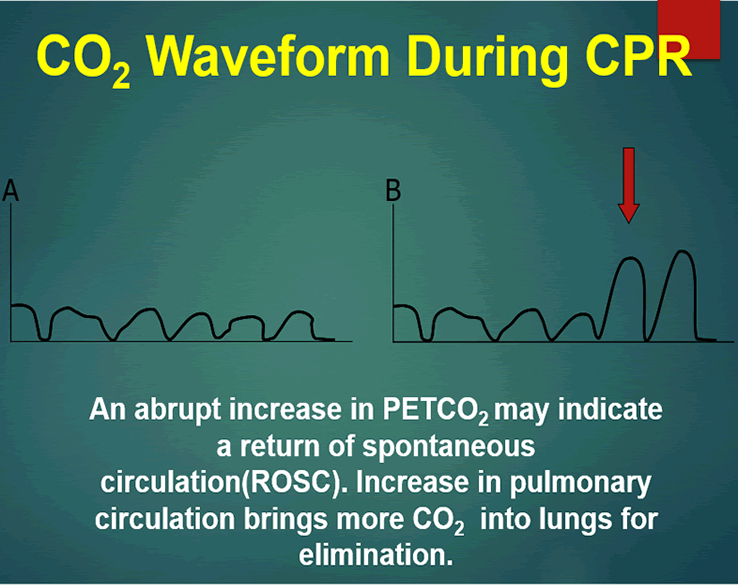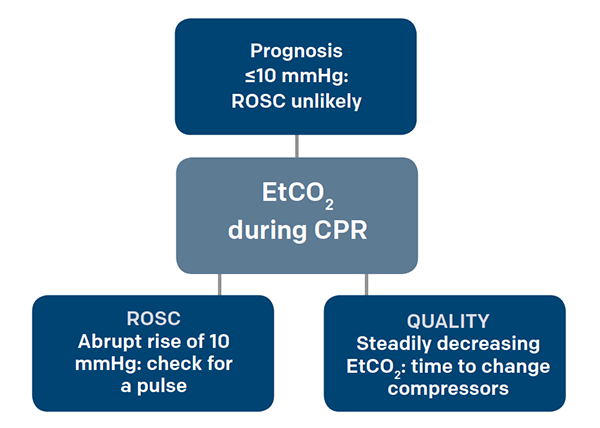low end tidal co2 during cpr
1 evaluating the effectiveness of chest compressions and 2 identification of ROSC. What are the origins of these numbers.

Cpr Mobile Code Stand With Capnograph Capnography
CPR is a low cardiac output state during which E tco 2 becomes less dependent on CO 2 production and ventilation and more linearly related to cardiac output.

. Abrupt increase in ETCO2 suggests ROSC during CPR detectable before pulse check ETCO2 at 20 minutes of CPR is prognostically useful. Low end tidal co2 during cpr. Two very practical uses of waveform capnography in CPR are.
Low ETCO2 below 10 mm HG may be caused by either poor compression technique or from low perfusion and metabolism after a long downtime or shock despite good compressions. Throughout the resuscitation end-tidal CO 2 was consistently in the 28-36 mmHg range during VFCPR. Average Etco2 Kpa During Cpr In Patients With Or Without Rosc Download Scientific Diagram.
Evidence suggests a persistently low ETco 2 value and a widened Paco 2-to-ETco 2 gradient during CPR are associated with poor outcomes. End-tidal carbon dioxide. End-tidal carbon dioxide ETCO2 correlates with systemic blood flow and resuscitation rate during cardiopulmonary resuscitation CPR and may potentially direct chest compression performance.
Measurement of a low ETCO 2 value 10 mmHg during CPR in an intubated patient suggests that the quality of chest compressions needs improvement. Continuous Waveform Capnograpy is written as PETCO2 which stands for patient end-tidal carbon dioxide. CPR is a method of capping.
Normal ETCO2 in the adult patient should be 35-45 mmHg. 16 28 After ventricular. What Should End Tidal Co2 Be During Cpr.
We compared ETCO2-directed chest compressions with chest compressions optimized to pediatric basic life support guidelines in an infant swine model to. Uses during cardiac arrest. By measuring exhaled CO2 many types of pulmonary assessments can be made.
What does end-tidal CO2 tell you. Patient end-tidal carbon dioxide. 1 ACLS guidelines define high quality chest compressions as achieving ETCO2 pressures of at least 10-20 mmHg.
35-40 mm Hg PETCO2 less than 10 indicates ineffective chest compressions. Gradual fall in ETCO2 suggests compressionist fatigue during CPR - time to change compressionists. Why is ETCO2 low during CPR.
A rapid rise in EtCO 2 during CPR can indicate ROSC due to the improved oxygen delivery to tissues that were compromised during cardiac arrest. Capnography may be especially useful in cardiac arrest patients as other conventional markers of endotracheal tube placement may be less reliable in these patients eg auscultation is impossible during cardiopulmonary resuscitation and low CO2 production may make qualitative paper indicators of CO2 difficult to interpret. Ensure proper rate approximately 100min Ensure proper depth with adequate releaserecoil of thorax 12 thorax or minimum 25 inches Persistently low EtCO.
The normal EtCO2 level is about 14 and the ideal CPR will provide at least 14 of the cardiac output. Low ETCO2 below 10 mm HG may be caused by either poor compression technique or from low perfusion and metabolism after a long downtime or shock despite good compressions. The height of the etco2 waveform during cpr has been used as an indirect measure of adequate chest compressions helping those involved in resuscitation monitor the effectiveness of their compressions in real time.
End-tidal carbon dioxide ETco2 monitoring provides valuable information about CO2 production and clearance ventilation. Studies have shown that in patients who had ETCO2 of 10 mmHg or less cardiac arrest was associated with death 13 14. 20 mmHg at 20 minutes CPR - higher chance of ROSC.
This will cause a decrease in the ETCO2 end-tidal CO2 and this will be observable on the waveform as well as with the numerical measurement. Ideally teams should aim for EtCO2 levels of 10 mm Hg and ideally 20 mm Hg. Thus ETco 2 monitoring is a noninvasive way to measure coronary artery blood flow and return of spontaneous circulation during CPR.
This pattern not previously described is different from that observed in animal and adult cardiac arrest caused by ventricular fibrillation during which ETCO2 decreases to almost zero after the onset of arrest begins to increase after the onset of effective CPR and increases to. On average during CPR if adequate chest compressions are being delivered a cardiac index of 16-19 Lminm2 can be generated which correlates with ETCO2 pressures of 20mmHg. 25 26 27 Flow of systemic venous blood to the pulmonary vasculature becomes ratelimiting for the elimination of CO 2 and a surrogate for blood flow produced by chest compressions.
After 20 minutes of CPR death occurs if ETCO2 is consistently below 10 mmHg with 100 sensitivity and specificity 15. Another use of ETco 2 monitoring is during procedural sedation and analgesia PSA. During CPR ETCO2 levels were initially high decreased to low levels and increased again at ROSC.
ETCO2 is a reliable indicator with a high prognostic value in determining the CPR outcome 11 12. A sustained drop or low. These levels of CO 2 were consistent with effective chest compression generating reasonable pulmonary blood flow justifying continuation of resuscitation.

Use End Tidal Capnography For Placing Orogastric Nasogastric Tubes And Cpr Page 2 Of 4 Acep Now Page 2
Emdocs Net Emergency Medicine Educationcapnography In The Ed Emdocs Net Emergency Medicine Education

Average Etco2 Kpa During Cpr In Patients With Or Without Rosc Download Scientific Diagram

3 Waveform Capnography Showing Changes In The End Tidal Carbon Dioxide Download Scientific Diagram

The Impact Of Ventilation Rate On End Tidal Carbon Dioxide Level During Manual Cardiopulmonary Resuscitation Resuscitation

Waveform Capnography In The Intubated Patient Emcrit Project

Etco2 Valuable Vital Sign To Assess Perfusion The Airway Jedi

3 Waveform Capnography Showing Changes In The End Tidal Carbon Dioxide Download Scientific Diagram

Capnography During Cardiopulmonary Resuscitation Current Evidence And Future Directions